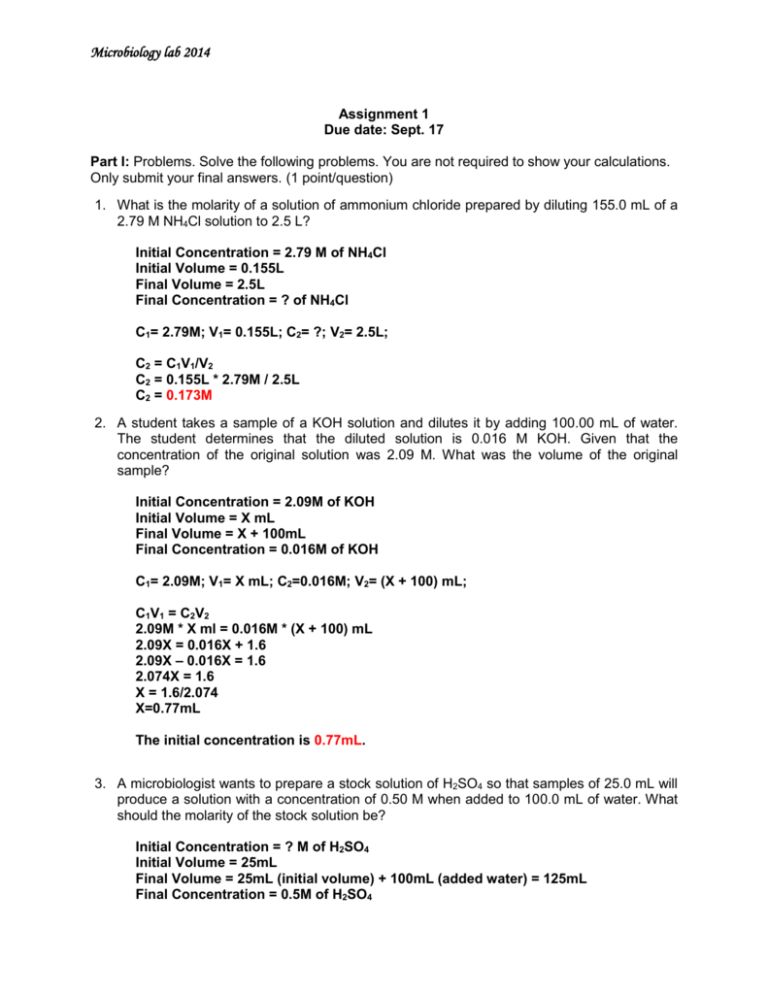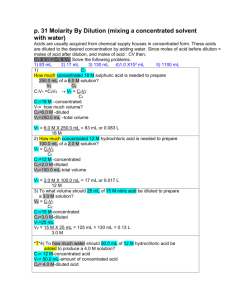Microbiology lab 2014 Assignment 1 Due date: Sept. 17 Part I
advertisement

Microbiology lab 2014 Assignment 1 Due date: Sept. 17 Part I: Problems. Solve the following problems. You are not required to show your calculations. Only submit your final answers. (1 point/question) 1. What is the molarity of a solution of ammonium chloride prepared by diluting 155.0 mL of a 2.79 M NH4Cl solution to 2.5 L? Initial Concentration = 2.79 M of NH4Cl Initial Volume = 0.155L Final Volume = 2.5L Final Concentration = ? of NH4Cl C1= 2.79M; V1= 0.155L; C2= ?; V2= 2.5L; C2 = C1V1/V2 C2 = 0.155L * 2.79M / 2.5L C2 = 0.173M 2. A student takes a sample of a KOH solution and dilutes it by adding 100.00 mL of water. The student determines that the diluted solution is 0.016 M KOH. Given that the concentration of the original solution was 2.09 M. What was the volume of the original sample? Initial Concentration = 2.09M of KOH Initial Volume = X mL Final Volume = X + 100mL Final Concentration = 0.016M of KOH C1= 2.09M; V1= X mL; C2=0.016M; V2= (X + 100) mL; C1V1 = C2V2 2.09M * X ml = 0.016M * (X + 100) mL 2.09X = 0.016X + 1.6 2.09X – 0.016X = 1.6 2.074X = 1.6 X = 1.6/2.074 X=0.77mL The initial concentration is 0.77mL. 3. A microbiologist wants to prepare a stock solution of H2SO4 so that samples of 25.0 mL will produce a solution with a concentration of 0.50 M when added to 100.0 mL of water. What should the molarity of the stock solution be? Initial Concentration = ? M of H2SO4 Initial Volume = 25mL Final Volume = 25mL (initial volume) + 100mL (added water) = 125mL Final Concentration = 0.5M of H2SO4 Microbiology lab 2014 C1= ? M; V1= 25mL; C2=0.5M; V2= 125mL; C1 = C2V2 / V1 C1 = 0.5M * 125mL / 25mL C1 = 2.5M 4. What volume of water should be added to 1.19 mL of an 8.0 M acetic acid solution in order to obtain a final concentration that is 1.5 M acetic acid? Initial Concentration = 8.0M of acetic acid Initial Volume = 1.19mL Final Volume = ? mL Final Concentration = 1.5M of acetic acid C1= 8.0M; V1= 1.19mL; C2=1.5M; V2= ? mL; V2 = C1V1 / C2 V2 = 1.19mL * 8M / 1.5M V2 = 6.35mL Volume of added water = 6.35mL – 1.19mL = 5.14mL H2O 5. Three solutions "A", "B", and "C" are mixed to obtain the following ratio: A:B:C = 1:2:27. What are the dilution factors for each of these compounds? A = 1/30, therefore A (dilution factor) = 30/1 = 30x B = 2/30, therefore B (dilution factor) = 30/2 = 15x C = 27/30, therefore C (dilution factor) = 30/27 = 1.11x 6. A microbiologist has three microbial cultures: E.coli at a density of 1 X 108 cells/mL, B. subtilis at a density of 5 X 109 cells/mL, and P. notatum at a density 2.5 X 109 cells/mL. From these, he wishes to prepare a single mixture containing 5 X 106 cells/mL of E.coli, 1.25 X 108 cells/mL of B. subtilis, and 1 X 105 cells/mL of P. notatum in a final volume of 10mL of media. What volume of media and of each of the original cultures should be used to achieve this? E.Coli: Initial Concentration = 1 x 108 cells/uL Initial Volume = ? mL Final Volume = 10mL Final Concentration = 5 x 106 cells/uL C1= 1 x 108 cells/uL; V1= ?mL; C2= 5 x 106 cells/uL; V2= 10mL; V1 = C2V2 / C2 V1 = 1 x 108 cells/uL * 10mL / 5 x 106 cells/uL V1 = 0.5mL Volume of initial E.Coli culture = 0.5mL Microbiology lab 2014 B.Subtilus: Initial Concentration = 5 x 109 cells/uL Initial Volume = ? mL Final Volume = 10mL Final Concentration = 1.25 x 108 cells/uL C1= 5 x 109 cells/uL; V1= ?mL; C2= 1.25 x 108 cells/uL; V2= 10mL; V1 = C2V2 / C2 V1 = 5 x 109 cells/uL * 10mL / 1.25 x 108 cells/uL V1 = 0.25mL Volume of initial B.Subtilus culture = 0.25mL P.notatum: Initial Concentration = 2.5 x 109 cells/uL Initial Volume = ? mL Final Volume = 10mL Final Concentration = 1 x 105 cells/uL C1= 2.5 x 109 cells/uL; V1= ?mL; C2= 1 x 105 cells/uL; V2= 10mL; V1 = C2V2 / C2 V1 = 2.5 x 109 cells/uL * 10mL / 1 x 105 cells/uL V1 = 0.0004mL Volume of initial P.notatum culture = 0.0004mL Volume of culture media = 10mL – (0.5mL + 0.25mL + 0.0004mL) = 9.25mL 7. 7 parts of water are added to 1 part of a 3.8 M solution of FeSO4. What is the molarity of the diluted solution? 7 Parts Water 1 Part FeS04 C1= 3.8M; V1= 1 part; C2= ?M; V2= 8parts; C2 = C1V1 / V2 C2 = 3.8M * 1 part / 8 parts C2 = 0.475M 8. A microbiologist prepares 480 mL of a 2.50 M solution of K2Cr2O7 in water. A week later, 39 mL of water has evaporated. How many moles of K2Cr2O7 are left and what is the new molarity of the solution? Initial Concentration = 2.5M Initial Volume = 480 mL Microbiology lab 2014 Final Volume = Initial Volume – Evaporated water = 480mL – 39mL = 441mL Final Concentration = ?M C1= 2.5M; V1= 480mL; C2= ?M; V2= 441mL; C2 = C1V1 / V2 C2 = 2.5M * 480mL / 441mL C2 = 2.72M Initial # of K2Cr2O7 moles = Final # of K2Cr2O7 moles 2.5M * 0.48L = 2.72M * 0.441L 1.2 moles = 1.2 moles Final # of K2Cr2O7 moles = 1.2 moles 9. A chemical test has determined the concentration of 100 mL of a solution of an unknown substance to be 2.41 M. The solution is totally evaporated, leaving 9.56 g of crystals of the unknown solute. What is the molar mass of the unknown substance? Volume = 0.1L Concentration = 2.41M Therefore, # of moles = 0.1L * 2.41M = 0.241 moles Molar mass = Mass of crystals / # of moles Molar mass = 9.56g / 0.241moles Molar mass = 39.67 g/moles 10. How many milliliters of a 250mg/mL chloramphenicol solution are needed for a 4 g dose? Volume of chloramphenicol (250mg/mL) for 4g dose = Masse / Concentration Volume of chloramphenicol (250mg/mL) for 4g dose = 4000mg / 250mg/mL Volume of chloramphenicol (250mg/mL) for 4g dose = 16mL 11. A pharmacist hands you a 1.5L bottle of a 20% (m/v) NaCl solution and asks that you mix it with sterile water to make as much of a 0.1M solution as possible. How much sterile water would you use? (MW of NaCl 58g/mole) Convert NaCl concentration from % (m/v) to molarity: 20% NaCl = 20g/100mL 20% NaCl = 200g/1000mL # of moles / 1L = Mass in 1000mL / MM # of moles / 1L = 200g / 58g/mole # of moles / 1L = 3.45 moles Therefore, molarity of 20% NaCl = 3.45M Initial Concentration = 3.45M Initial Volume = 1.5L Microbiology lab 2014 Final Volume = ?L Final Concentration = 0.1M C1= 3.45M; V1= 1.5L; C2= 0.1M; V2= ?L; V2 = C1V1 / C2 V2 = 3.45M * 1.5L / 0.1M V2 = 51.75L Needed sterile water = Final Volume – Initial Volume Needed sterile water = 51.75L – 1.5L Needed sterile water = 50.25L 12. The following dilutions were performed to determine the concentration of bacteria in a culture. What was the concentration of bacteria in the stock? 2 mL 1 mL 5 mL 10 mL 0.1 mL Stock 8 mL 4 mL 15 mL 150 colonies 10 mL Dilution 1 = 2mL / 10mL = 1/5 Dilution 2 = 1mL / 5mL = 1/5 Dilution 3 = 5mL / 20mL = 1/4 Dilution 4 = 10mL / 20mL = 1/2 Serial dilution = 1/5 * 1/5 * 1/4 * 1/2 = 1/200 Therefore, the dilution factor is = 200/1 = 200x Concentration = Dilution factor * # of Colonies on plate * factor to bring amount plated to 1mL Concentration = 200 * 150 * 10 Concentration = 3 * 105 cells/mL 13. 52mL of sodium cyanide poison leaked from a bottle, which originally contained 100mL, into a bucket of water containing 428mL of water. The concentration of poison in the bucket was found to be 0.85 M after the leak. If the molecular weight of sodium cyanide is 49g/mole, how many grams of sodium cyanide remain in the bottle? Volume of new cyanide solution = 52mL of original solution + 428mL of water Volume of new cyanide solution = 480mL Initial Concentration = ?M Initial Volume = 52mL Final Volume = 480mL Final Concentration = 0.85M Microbiology lab 2014 C1= ?M; V1= 52mL; C2= 0.85M; V2= 480mL; C1 = C2V2 / V1 C1 = 0.85M * 480mL / 52mL C1 = 7.85M Therefore, concentration of initial cyanide solution = 7.85M # of moles left in the initial bottle = volume left * molarity # of moles left in the initial bottle = 0.048L * 7.85M # of moles left in the initial bottle = 0.3768 moles Mass of cyanide left in the initial bottle = # of moles * MM Mass of cyanide left in the initial bottle = 0.3768 moles * 49g/mole Mass of cyanide left in the initial bottle = 18.4632g 14. Concentrated hydrochloric acid has a concentration of 37.7% (m/m). What is its molar concentration? (The density of the solution is 1.19 g/mL and MW of HCL: 36g/mole) Concentration 37.7% (m/m) = 37.7g HCl / 100g solution 100g solution in mL = mass / density 100g solution in mL = 100g / 1.19g/mL 100g solution in mL = 84mL Concentration 37.7% (m/m) = 37.7g HCl / 84mL solution Mass of HCl in 1L of solution : 1000mL / 84mL = 11.9 (37.7g HCl / 84mL solution) * 11.9 = 448.63g / 1000mL Molarity = Masse of HCl in 1L / MM Molarity = 448.63g / 36 g/mole Molarity = 12.5M 15. You wish to prepare a tetracycline solution of 1mg/ml in ethanol from a 10mg/ml stock solution of tetracycline. Given that you have 10ml of the tetracycline stock solution and 5 ml of ethanol, what is the maximum volume of the diluted solution that you can prepare? First find which reagent is limiting, in this case it’s the ethanol. Initial Concentration = 10mg/mL Initial Volume = XmL of 10mg/mL Final Volume = XmL of 10mg/mL + 5mL of ethanol Final Concentration = 1mg/mL C1= 10mg/mL; V1= XmL; C2= 1mg/mL; V2= X + 5 mL; C1V1 = C2V2 Microbiology lab 2014 10mg/mL * X mL = 1mg/mL * (X + 5) mL 10X = 1X + 5 9X = 5 X = 5/9 X = 0.556mL Therefore, Volume of 1mg/mL of tetracycline produced = X + 5 mL Volume of 1mg/mL of tetracycline produced = 0.556ml + 5mL Volume of 1mg/mL of tetracycline produced = 5.556mL






